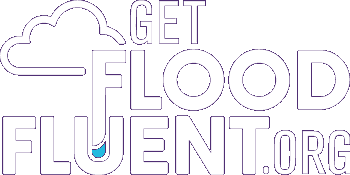If people weren’t confused about their flood risk and flood insurance, we wouldn’t be here. So what exactly are they?
Read on…
What do I need to know?
What do I need to know about flood risk?
First, you need to know that your property IS at risk because… Anywhere it can rain, it can flood. Using FEMA’s Flood Insurance Rate Maps (FIRM) is a good starting point for understanding your property’s risk of flooding. Each community’s FIRM delineates different flood zones based on the type and probability of flooding.

There are currently nine different types of flood zones on Flood Insurance Rate Maps for Hampton Roads communities. Use the map here to find out what flood zone your home is in.
- Type your address in the search block and click the magnifying glass
 to find your property.
to find your property. - Zoom in and click on the gray outline of your property.
- Once your property is selected, click the arrow
 to see the flood zone in the pop-up info box.
to see the flood zone in the pop-up info box.
Zone A
These areas are subject to flooding at a one percent or greater annual chance of flooding in any given year. They are part of the Special Flood Hazard Area. No base elevations are shown for flood levels, so you should contact your local floodplain administrator to find out more information about the risk of flooding in these areas.
Zone AE
These areas are subject to flooding at a one percent or greater annual chance of flooding in any given year. They are part of the Special Flood Hazard Area. Base flood elevations have been calculated and are shown on the FIRM. (“Zone AE EL 8 Feet”)
Zone AH
These areas are subject to flooding at a one percent or greater annual chance of flooding in any given year. They are part of the Special Flood Hazard Area. Flooding in these areas usually results from ponding with average depths between one and three feet. Base flood elevations have been calculated and are shown on the FIRM. (“Zone AH EL 8 Feet”) These are relatively rare in Hampton Roads.
Zone AO
These areas are subject to flooding at a one percent or greater annual chance of flooding in any given year. They are part of the Special Flood Hazard Area. Flooding in these areas usually results from sheet flow with average depths between one and three feet. Base flood elevations have been calculated and are shown on the FIRM. (“Zone AO EL 8 Feet”) These are relatively rare in Hampton Roads.
Zone D
The flood hazards in these areas have not been determined. They are extremely rare in Hampton Roads and are currently only found on some federally owned properties.
Zone VE
These are coastal areas subject to flooding at a one percent or greater annual chance of flooding in any given year. They are part of the Special Flood Hazard Area. These areas are vulnerable to additional hazards associated with velocity wave action. Base flood elevations have been calculated and are shown on the FIRM. (“Zone VE EL 8 Feet”)
Zone X
These are considered areas of minimal flood hazard outside the 0.2 percent annual chance floodplain. No base flood elevations have been calculated.
Zone X (shaded)
These are considered areas of moderate flood hazards between the 0.2 percent and 1 percent annual chance floodplain. No base flood elevations have been calculated.
Floodways
These are not a separate zone, but are drawn as an overlay on top of Zone A or Zone AE areas. They are the channel of a river or other watercourse and the adjacent land areas that must be reserved in order to discharge the base flood without cumulatively increasing the water surface elevation more than a designated height. Development in these areas is subject to more stringent controls than other floodplains.
What are the areas with the highest risk of flooding?
If you are in a flood zone starting with A or V, then you are in what FEMA calls the Special Flood Hazard Area (SFHA). These are areas where the annual risk of flooding is at least 1%. Zones starting with A can flood due to rainfall, rivers overflowing their banks, high tides, and coastal storms. Zones starting with V are also vulnerable to waves – what FEMA refers to as “velocity wave action.”
Properties that are in the SFHA with a federally-backed mortgage are generally required to get flood insurance.
What does it mean if my flood zone has a second letter?
If your flood zone ends with E (AE or VE), H, or O, a base flood elevation (the elevation of the water during the 1% annual chance flood) has been calculated based on a detailed hydraulic analysis. Depending on the zone, the type of flooding analyzed may be coastal, riverine, or precipitation-driven.
What is the base flood elevation?
The base flood elevation is the elevation of the water during the one percent annual chance flood, or 100-year flood.
What is flood insurance?
Let’s begin with this: standard homeowners and renters insurance is not flood insurance and does not cover flood damage. If your home is filled with water as a result of rising bodies of lakes, rivers, streams, and oceans, and you believe your homeowners or renters insurance will cover you, you may be left high and dry. (Well, actually, you’ll be all wet.)
Most flood insurance is administered through the Federal Emergency Management Agency (FEMA) under a program called the National Flood Insurance Program (NIFP). That said, nearly 100 insurance companies write and service NFIP policies. So, whether you’re a homeowner, a renter or a business owner, you can purchase flood policies from an insurer under contract with FEMA.
Interested in seeing a quick estimate of what your flood insurance rate might be? Check out our Flood Risk Calculator.
Check with your current insurance agent to see if they offer flood policies.
If they don’t and you’d like a referral, contact the National Flood Insurance Program’s Help Center at 1-800-427-4661.
What does flood insurance cover?
Good question. It’s important to know what is and what isn’t covered by a flood insurance policy. Also, there are separate flood insurance policies for your building/structure and for your contents. (For example, if you’re a renter, you may only be interested in the contents policy.) You can buy one or both; each of these policies has its own deductible.
- A Building Property/Structure policy covers your actual home (building property) up to $250,000.
- A Personal Property/Contents policy covers your personal property up to $100,000.
Covered Building Property/Structure:
- The electrical and plumbing systems
- Furnaces, water heaters, heat pumps, and sump pumps
- Refrigerators, cooking stoves, and built-in appliances such as dishwashers
- Permanently installed carpeting over an unfinished floor
- Permanently installed paneling, wallboard, bookcases, and cabinets
- The damage must be directly caused by flood water
- Cabinets that were not damaged by flood water are not covered, even if they match cabinets that were damaged by flood water
- Foundation walls, anchorage systems, and staircases attached to the building
- There is an exclusion for “loss caused directly by earth movement even if the earth movement is caused by flood”
- A detached garage, used for limited storage or parking
- Up to 10 percent of the building coverage limit can be used, but will reduce the total amount of building coverage available
- Cisterns and the water in them
- Fuel tanks and the fuel in them, solar energy equipment, and well water tanks and pumps
- Window blinds
- The electrical and plumbing systems
- Furnaces, water heaters, heat pumps, and sump pumps
- Refrigerators, cooking stoves, and built-in appliances such as dishwashers
- Permanently installed carpeting over an unfinished floor
- Permanently installed paneling, wallboard, bookcases, and cabinets
- The damage must be directly caused by flood water
- Cabinets that were not damaged by flood water are not covered, even if they match cabinets that were damaged by flood water
- Foundation walls, anchorage systems, and staircases attached to the building
- There is an exclusion for “loss caused directly by earth movement even if the earth movement is caused by flood”
- A detached garage, used for limited storage or parking
- Up to 10 percent of the building coverage limit can be used, but will reduce the total amount of building coverage available
- Cisterns and the water in them
- Fuel tanks and the fuel in them, solar energy equipment, and well water tanks and pumps
- Window blinds
Covered Personal Property/Contents:
- Personal belongings such as clothing, furniture, and electronic equipment
- Curtains
- Portable and window air conditioners (easily moved or relocated)
- Portable microwave ovens and portable dishwashers
- Carpets not included in building coverage (carpet installed over wood floors, etc.)
- Clothes washers and dryers
- Certain valuable items such as original artwork and furs (up to $2,500)
- Food freezers and the food in them (but not refrigerators)
- Personal belongings such as clothing, furniture, and electronic equipment
- Curtains
- Portable and window air conditioners (easily moved or relocated)
- Portable microwave ovens and portable dishwashers
- Carpets not included in building coverage (carpet installed over wood floors, etc.)
- Clothes washers and dryers
- Certain valuable items such as original artwork and furs (up to $2,500)
- Food freezers and the food in them (but not refrigerators)
For a complete summary of coverage under an NFIP policy, go to what’s covered.
Commercial flood insurance is also available from the NFIP; it provides up to $500,000 of coverage for your building and up to $500,000 for its contents. Be sure to talk to your licensed insurance agent about what is and isn’t covered by your policy.
What is FEMA disaster assistance?
So let’s say you and your family (and, most likely, your neighbors) have experienced a flood in your area and there’s talk about disaster assistance. That kind of assistance only happens when there’s an official Individual Assistance Presidential Disaster Declaration. Just so you know, most flood events do not result in a declaration. If that happens though, government money is then made available to those who might need it due to the specific disaster, and if you talk to people who have received it, it’s typically not enough.
But here’s the thing. According to FEMA, disaster assistance comes in two forms:
- A U.S. Small Business Administration loan, which must be paid back with interest
- A FEMA disaster grant, which is about $5,000 on average per household
What does flood insurance offer you? Consider these two things:
- A flood insurance payout does not have to be repaid
- Just one inch of floodwater in your home can cause $25,000 damage, and the average flood insurance claim is nearly $30,000

